Rome is a one-of-a-kind city.
You already know it - from romantic movies, glossy magazines, TV shows, and scrolling through Instagram. But you are yet to experience the magic first-hand.
Your first trip to Rome will be memorable, guaranteed.
But whether it’s for good or not-so-good reasons... well, that’s up to you.
As an experienced traveller in Italy, I’m here to help you prepare and plan your trip, to ensure it's as smooth as butter.
Rome is not the kind of city you want to wing your way through, flying by the seat of your pants. Take the time to learn the culture, discover the nuances of what makes the Eternal City tick. Then you can navigate through its narrow cobblestone streets, oozing with an equal measure of confidence and open-eyed wonder.
Essential reading: If your trip to Rome will be part of a larger trip around Europe, check out my essential guide on how to plan a trip to Europe.

There are so many fascinating attractions, historical sites, tours, and foodie experiences in Rome, that you’ll want to do them all. But there are limited hours in the day, and dollars in the bank. So I will help you avoid overwhelm and focus your travel plan on a balanced mix of unmissable classic experiences and hidden gems.
Everything is covered, from transport and hotels to the essential things you will see, do and taste. This is pure, 100% practical advice – no Insta-cringy red flowing dresses.
Just enough inspiration to fill a dreamy 4-day getaway in Italy’s capital without overdoing it.
That’s the Italian way.
How To Save Money in Rome
The cost of travel in post-pandemic Europe has reached new highs, so to make your trip to Rome affordable, here are a few tips on how to save money:
Turbopass Rome City Pass
This is your golden ticket. It will save big dollars on over a dozen major attractions and, more importantly, your valuable time. Choose the optional public transport ticket to avoid the hassle of arranging that on the ground, but don’t add the airport transfer option (I’ll explain the best way to get to the airport later). Once purchased online, the e-tickets will be sent to you via email within 24 hours. Save a copy of this PDF on your phone for easy access. The physical public transport tickets are picked up at a kiosk near Roma Termini.
Note: the Turbopass is valid for consecutive calendar days. So if you use it for the first time at 5pm on Friday, that counts as your first day, with Saturday being the second. So plan your itinerary to make the most use of the city pass.


Use Public Transport
Rome is a big city, and while a lot of sightseeing can be done on foot, you can save time travelling long distances using the expansive bus and metro network. Traffic congestion often means a metro ride is quicker than an expensive taxi.

Book Tours and Attractions in Advance
The Colosseum requires a timed reservation (optionally included with the Turbopass Rome City Pass), and slots fill up. So the sooner you book this in advance, the better. Avoid scammers in front of the Colosseum selling tickets or tours.
Walks is my favourite tour operator in Rome. But they are also very popular (for good reason), especially during the peak summer season. To avoid disappointment, booking at least a few weeks in advance is recommended – preferably a month or two.
Money Tip: The first Sunday of every month offers free entry into Rome’s museums, including Colosseum. If you want to save money, this is one option – but expect more crowds.
Avoid Non-Bank ATMs
Italians love cash, and not all businesses accept debit/credit cards in Rome. ATMs attached to banks usually do not charge withdrawal fees, whereas private non-bank ATMs do. Those are often found near train stations, ports, airports, kiosks, and bars and have prominent signage saying “ATM”.
Check your home bank’s foreign exchange fees before leaving, and remember to notify them of your travel (to avoid your card being frozen for “security reasons”). Avoid using money exchangers, as their rates are always higher. I recommend the Wise debit card, which offers limited free withdrawals in many countries and great exchange rates.
Android app tip: Download this free currency converter which is fast and supports offline calculations (a paid “pro” version is available without ads).
Getting Around Rome
Walking. You’ll be doing a lot of it in Rome. Many beautiful roads and footpaths are lined with cobblestone, which looks romantic in photos, but can leave your feet feeling hungover the next day. Wear comfortable walking shoes with thick, cushioned soles and strong support. And don’t overlook high-quality socks – my favourite brand is FITS Socks.
Public transport is my preferred way to get around Rome. I was impressed with the thorough bus network, although the schedule is on “Italian timing,” and bus drivers may casually deviate from the route to avoid traffic. Metro trains tend to be more punctual and, fortunately, do not deviate from the tracks. Ticket machines are found at metro stops or can be purchased at tabaccheria (tobacco shops).
The most important app you need to download is Citymapper (iOS, Android). It’s much better than Google Maps, especially for public transport, with live updates on public transport schedules. This is a godsend when standing at a bus stop in Rome.
Note: Public transport tickets included with the shorter Rome City Pass (1, 2, or 3 days) are measured in hours (24, 48, or 72) – anything longer includes a 7-day public transport ticket.
Compared to cities like Paris and London, taxis in Rome aren’t ridiculously expensive. If you find the need to use one, I recommend the FreeNow app (rides are cheaper compared to Talixo and Uber). Trying to flag a taxi on the side of the road can be hit-or-miss, depending on the time of day.
E-scooters are a fun way to get around Rome… if you have a death wish or enjoy white-knuckle thrill rides. Driving any kind of vehicle on central Rome’s roads is not for the weak-of-heart. But if you feel adventurous and your last will and testament is up to date, the most popular apps are Bird, Lime, and Dott.
If you’re flying in to Rome-Fiumicino International Airport (FCO), the cheapest and fastest way to get into the city is via the Leonardo Express train. Costing €14pp and running every 15 minutes, it only takes 32 minutes to reach the central train station, Roma Termini. Tickets can be purchased from automated machines at the airport (with cash or card) – no need to buy in advance. Groups of 4 can be purchased at a discounted rate of €40 (instead of €56). Note: regular public transport tickets are not valid on Leonardo Express.


Essential Tours in Rome for a First-Time Visitor
Street Food tour in Jewish Quarter and Centro Storico (with Pizza Making!)
Food is the beating heart of Rome, and the best way to experience authentic food is with a knowledgeable local guide. This small group tour by Devour (a sister company of Walks) was one of the highlights of my trip to Rome.
Our guide, John-Paul, was more like a local friend than a typical tour guide. Not only informative, but also humorous and relatable. He was able to adjust some of the tastings for me to be vegan-friendly. And beyond the tour, John-Paul was happy to answer any questions I had while in Rome – what more could you ask for?
Starting from the ancient ruins of Portico D'ottavia, John-Paul led us through the fascinating stories behind iconic and unique foods in Rome, dating back to the 1500s. Tastings included Jewish-style deep-fried artichoke, suppli, fried cod filet, and craft beer. Then we went behind the scenes at a restaurant to create our own hand-stretched wood-fired pizzas, before finishing off with artisanal gelato.
Vatican Museums & Sistine Chapel
It takes at least a full day to do the Vatican justice. I recently tried a newer experience from Walks which included a guided tour of Vatican Museums, the Sistine Chapel, plus a trip via the Pope’s private train to Castel Gandolfo, around 1.5 hours southeast of Rome. This mammoth 10-hour tour only runs once per week, and space is limited, so book early.
The morning started at 7:45am, with a knowledgeable in-house guide from Vatican Museums taking the small group through the most important rooms and exhibits filled with sculptures, paintings, frescos, mosaics, tapestries, ornaments, and more. After a stroll through the Vatican gardens, we boarded a train that whisked us non-stop to the lakeside town of Albano Laziale, where we transferred via bus to Castel Gandolfo. A delicious lunch was served on the castle grounds (vegetarian and vegan options available). Then a different guide led us around the expansive Giardini di Villa Barberini and Palazzo Barberini – before exploring the ornate Papal Palace, the Pope’s summer palace.

Vatican Tip: If you don’t want a full guided tour, skip-the-line tickets are included with Turbopass. It’s best to arrive at least 30 minutes before opening as the museum gets super crowded. But there’s so much to see, and trying to discover everything without a guide is not advisable.
Clothing Tip: The Vatican has a strict dress code – no shorts or skirts above the knee and no sleeveless tops.
Essential Things To Do in Rome for a First-Time Visitor
Colosseum
This is probably the first thing that comes to mind when you think of Rome. For almost 2 millennia, this double amphitheatre has captured the world's imagination, and it continues to as one of the New 7 Wonders of the World. Due to overwhelming tourist demand, the only way to enter the Colosseum is with a time-slot ticket. Entry is optionally included with the Turbopass Rome City Pass, but if you don’t choose that, only book your tickets on the official website. The sooner you book in advance, the better.
A PDF e-ticket is provided upon purchase, to be shown on your phone at the entry gate. Arrive 15 minutes before your slot to allow time for a security check.
Tip: Use Rick Steve’s free MP3 audio guides (and accompanying maps) for the Colosseum, Roman Forum, and Pantheon. It will add another dimension to these historical sites.
Roman Forum & Palatine Hill
This was the nucleus of the ancient Roman Empire – bustling markets alongside temples. All that is left is ruins and basic signage, so the above Rick Steves audio guide will bring this place to life. Use the same ticket as Colosseum, but entry can be any time during a 24-hour window from first use.
Tip: The north entrance is far less busy, with smaller queues (if any).
St. Peter's Basilica
This is the largest and most important cathedral in the world, and the bosom of the Catholic Church. Entry is free, but there’s a fee to climb to the top of the dome. Turbopass includes €5 discount on a guided tour (when booked directly).
Tip: Take a walk west along Via della Conciliazione toward St Peter’s Square at sunset for stunning views of Michelangelo’s dome.


Castel Sant’Angelo
Since 135 AD this imposing building has played several roles – mausoleum, fortress, castle, ammunition storage depot, and now a tourist attraction. Entry is included with Turbopass, however, tickets must be picked up at one of three convenient locations in advance, and a timeslot chosen. Timed slots have limited entries, so to avoid disappointment, it’s best to arrange tickets at least 1 day in advance (but earlier if possible).
Tip: Take a stroll along St. Angelo Bridge, amongst larger-than-life sculptures lining the pedestrian bridge, alongside portrait artists and street performers.

Pantheon
A former Roman temple converted into a Christian church. This is still the world’s largest unreinforced concrete dome after 2,000 years. Amazing! Free entry, but queues may be long in summer. Turbopass includes free physical audio guide rental.
Note: As it’s an active place of worship, there is the usual dress code (cover shoulders and knees) – although this is loosely enforced (I saw plenty of visitors wearing shorts).
Trevi Fountain
Possibly the most famous fountain in the world thanks to the classic 1950s movies “Roman Holiday” and “3 Coins in the Fountain”. Situated upon an endpoint for an ancient aqueduct dating back to 19 BC, the current elaborate design was completed in 1762. Legend says that a coin tossed over your left shoulder from your right hand will ensure a return to Rome. So if you want to come back, bring a coin. Access is free but get there by 6:30am to avoid the crowds.
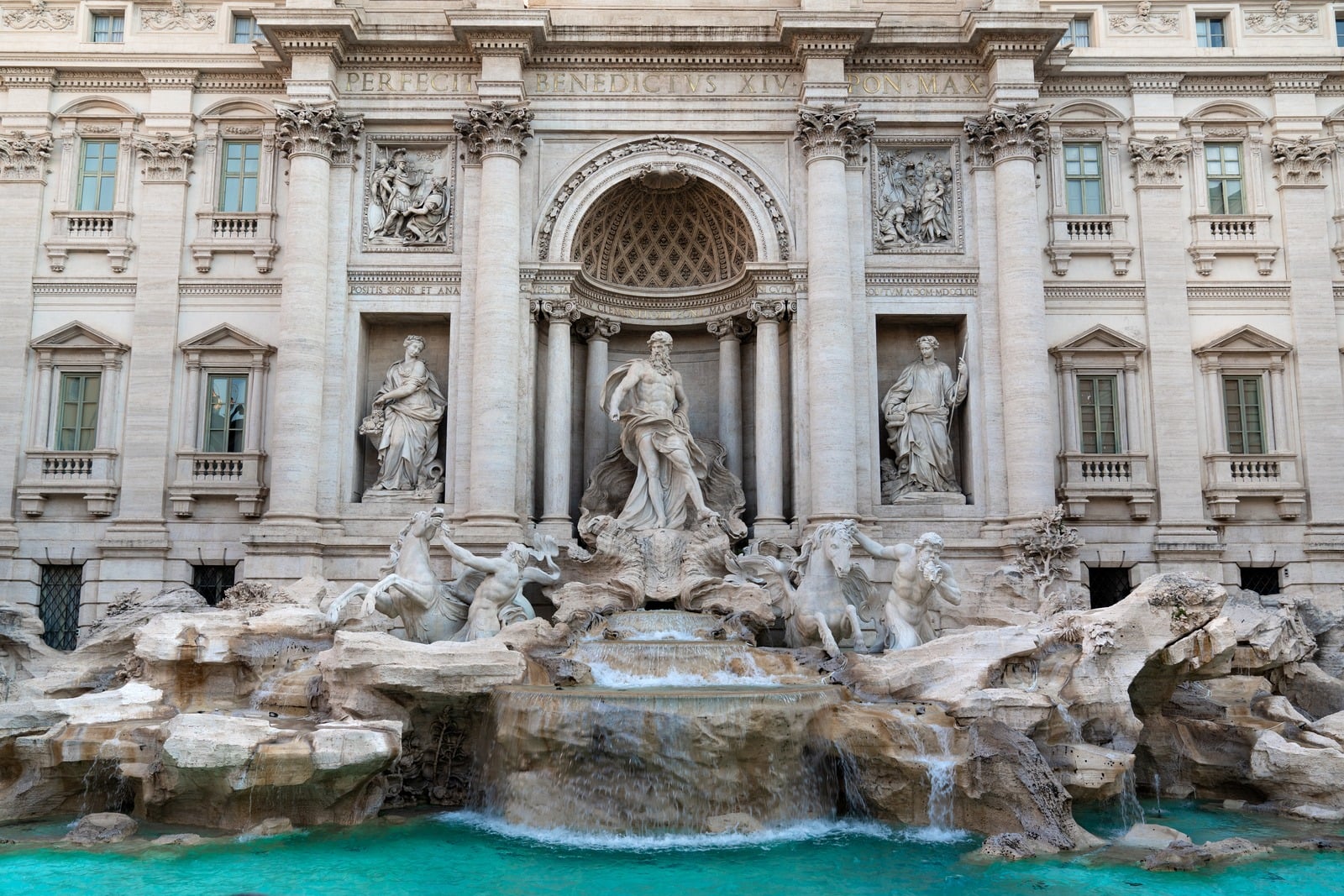
Piazza Navona
There are more elegant town squares in Rome than you could see in a year. If you’re short on time and can only see one, this should be it. The elongated rectangular space was the site of an ancient stadium around 2,000 years ago. After being used as a marketplace from the 15-19th century, it’s now lined with restaurants and shops, and adorned with 3 beautiful baroque fountains.
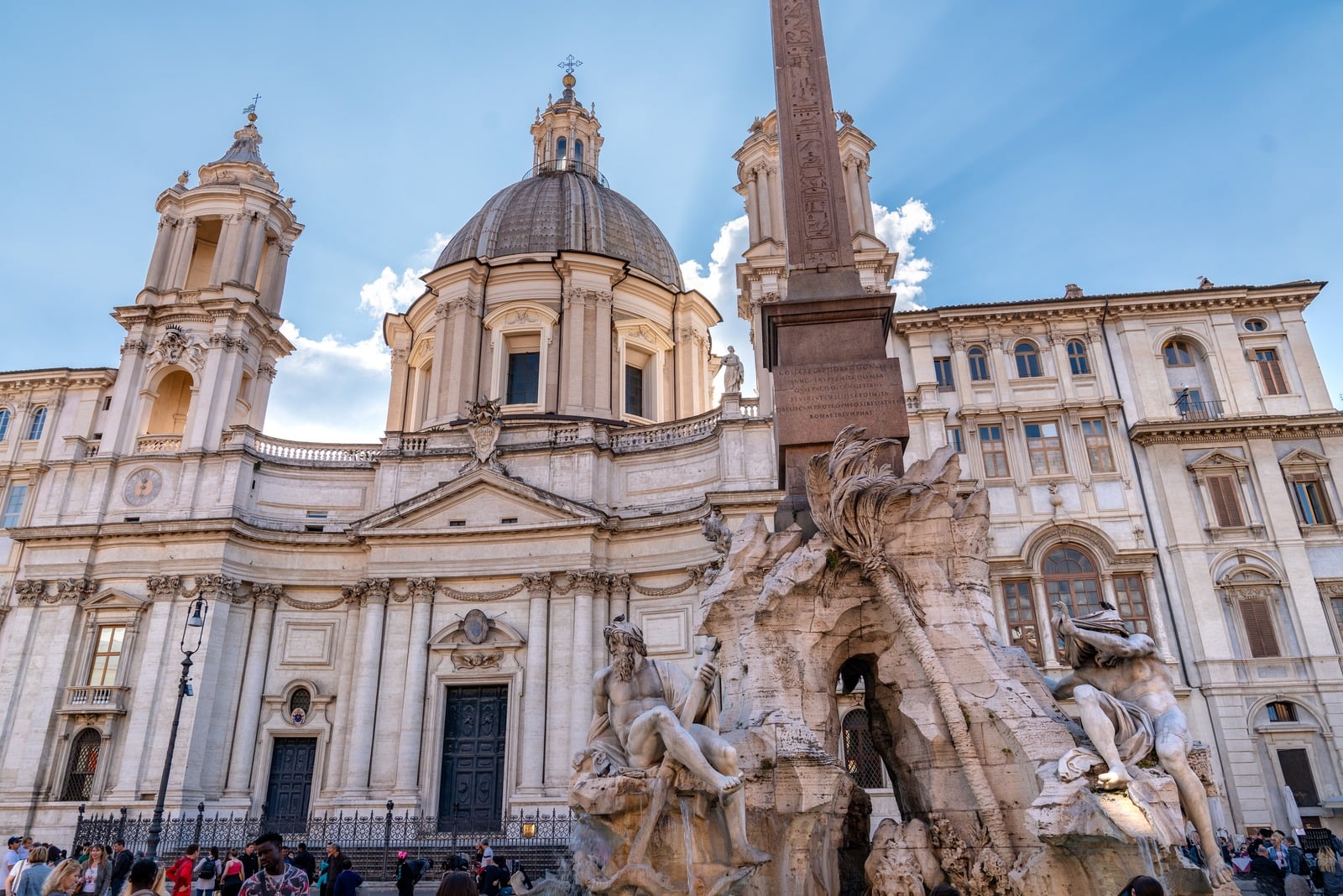
Spanish Steps
Starting from a small baroque ship-shaped fountain in Piazza di Spagna, these iconic 18th-century steps lead up to the monastery church Trinità dei Monti. Confusingly, it was commissioned by a French king but named after the former Spanish embassy in the square. While it used to be a popular spot to relax, from July 2019, the mayor introduced strict fines of €250 for sitting on the steps and even higher fines for eating. There are small stone benches in front of the fountain at the base. Like most popular public sites in Rome, it’s best experienced early (before 7am) before crowds descend and the temperature rises.
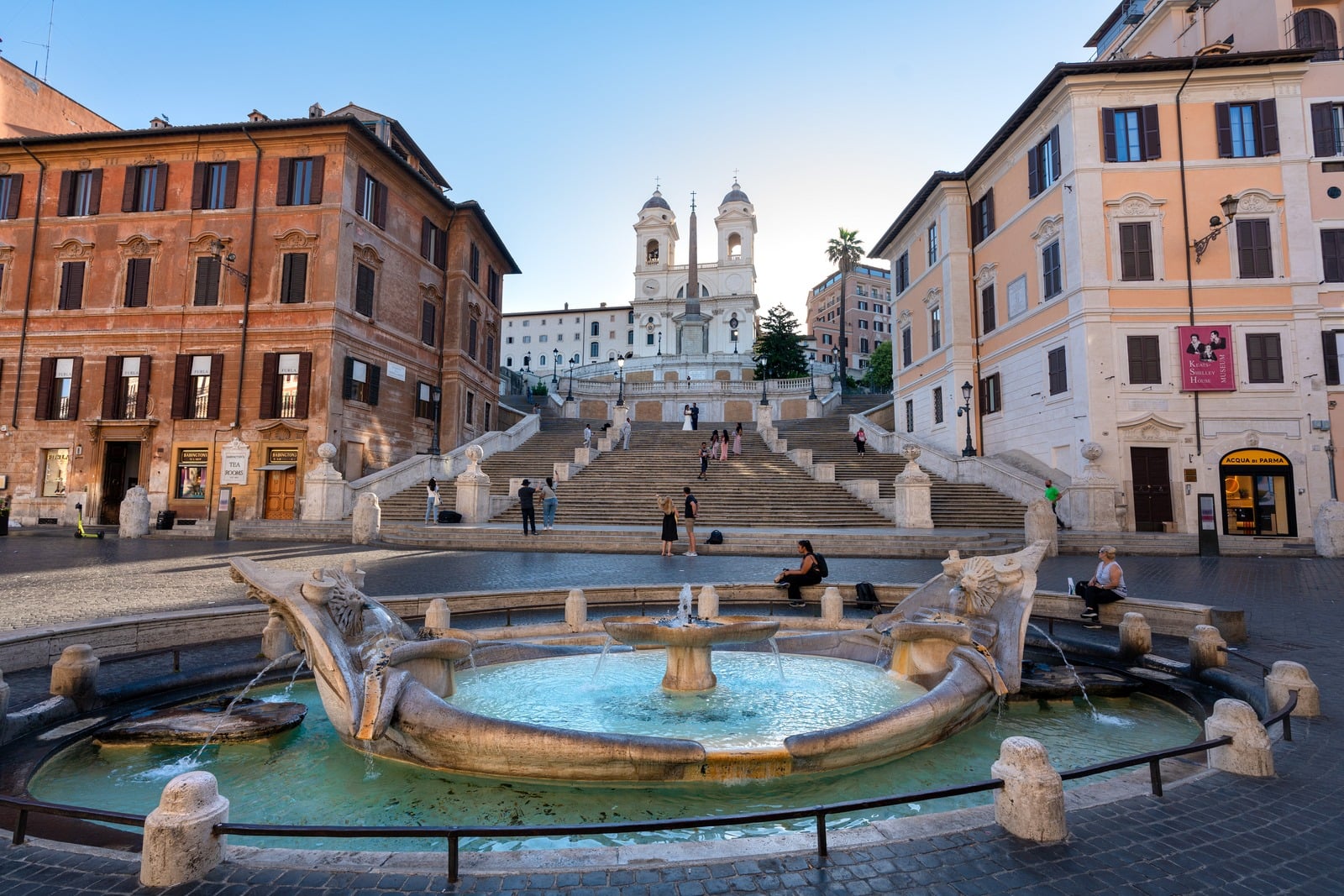
Altar of the Fatherland
Built in honour of Victor Emmanuel II, the first king of a unified Italy, this series of marble-clad structures, fountains, staircases, and statues is a proud symbol of modern Italy. Enjoy the view for free from Piazza Venezia, which is especially magical at sunset.

Largo di Torre Argentina
While these ancient Roman ruins are centrally located, many passers-by are unaware of their historical significance. This is where Julius Cesar was assassinated by a group of senators in 44 BC. So watch your back!
Hop On Hop Off Bus
If your feet need a break, take a lap of Rome on the open-top tourist bus with an audio guide. There are multiple convenient stops around the city, but I recommend starting here. A 24-hour ticket is included with the Turbopass Rome City Pass.
Essential Food to Try in Rome
Carbonara
Rome is the home to this classic creamy pasta dish (although it never has cream!). You can find it in almost every Italian restaurant. I found a delicious vegan version at Rifugio Romano (best to reserve a table in advance).

Suppli (Rice Balls)
This is a giant deep-fried tomato rice ball, stuffed with mozzarella cheese. Closely related to the famous arancini, which heralds from Sicily, Suppli is Rome’s king of street foods.

Pizza Al Taglio
This is how locals eat pizza in Rome - cut into squares and priced by weight. While you might be spoilt for choice, locals simply ask for whatever is freshest. If you experience a language barrier, pointing and hand gestures do the job.

Maritozzi (Cream-Filled Buns)
Yeast buns pumped with whipped cream are typically enjoyed for breakfast. These are found in pastry shops and espresso bars all over the city. I found maritozzi at a small espresso bar near Trevi Fountain.
Carciofi alla Giudia (Deep Fried Artichokes)
A dish inspired by Rome’s Jewish community in the 1500s. Crunchy, salty, and closely resembling the texture of a crispy potato chip, it’s simply mouth-watering. After a bad experience in childhood, I swore never to eat artichoke again. But I gave it another shot and was so glad I did. Try it at this small family-owned restaurant.
Gelato
There are more gelato shops in Rome than you can poke a stick at, so you’ll be spoilt for choice. But when it comes to quality and service, I recommend Gelateria camBIOvita, which has plenty of vegan options and only uses natural ingredients. Grab a cup and stroll through the dreamy narrow cobblestone streets of the surrounding neighbourhood, Parione, at sunset.

Craft Beer
While it’s easy to find a wine bar. You might not have realised there’s a budding craft beer scene in Rome. Locals just grab a can or two, and relax and socialize on the street in the cool of the early evening. Try this hidden gem for a wide range of Italian beers - Johnny's Off License.

Extra Tips for First-Time Visitors to Rome
These are things I wish someone had told me before I visited Rome for the first time.
Language
A significant portion of Italians in Rome speak some English, but not all. It helps to learn a few basic phrases in Italian, especially “please” and “thank you”. Install Google Translate with offline support for Italian, for easy scanning of labels and signs. The new “audio transcribe” tool is a lifesaver when trying to hold a basic conversation with a shopkeeper.
If you want to take your Italian further for a more immersive experience, I recommend this intuitive online course. This focuses on spoken Italian rather than reading and writing. Read my full review for more details.
Stay Connected
Get a SIM (or eSIM) card so you’re connected to the Internet – don’t rely on hopping between WiFi hotspots. Read my article for more details about eSIMs in Europe. I used a SIM from Holafly, with unlimited data, to stay connected all over Europe. I’d be lost without it… literally!
Navigate Like A Pro
Use the mobile app Citymapper (iOS, Android) rather than Google Maps for navigating the public transport network. The live arrival times help to avoid wasting time standing at a bus stop, when you could be enjoying another slice of pizza or sightseeing.
Stay Hydrated
Nasoni (which means “large noses”) are free freshwater taps scattered around the city. This drinking water is clean, perfectly safe and flows constantly. They are easy to spot thanks to the unique design, and with over 2,500 nasoni around Rome, there’s always one nearby. In summer, Rome’s temperature can reach upwards of 100°F (38°C) and a full day of sightseeing will take a toll on your body. Carry a refillable bottle and drink water regularly to avoid headaches and dehydration symptoms.

Eat Breakfast
For a city that thrives on food culture, you’ll be surprised that Rome is lacking in the breakfast department. You’ll find many “bars” – but these are coffee bars. Locals stand at a coffee bar (to avoid paying “table service”) with a cornetto in hand, sip an espresso and then dash off. If you want a decent breakfast, enjoy it at your hotel or do it yourself – I picked up oat milk and cereal from a small supermarket.
Faux Pas
There are plenty of stories floating around the Internet about dos and don’ts in Rome. Some are true. Others are myths. Just watch the locals and do what they do.
- True: Don’t drink cappuccino with a meal. Just drink it by itself. With a meal, choose water or wine.
- Myth: Don’t drink espresso after 11am.
- True: Don’t add milk in your espresso after lunch. It hinders digestion.
- Myth: Italians don’t know what a “latte” is.
- True: Don’t ask for “latte” unless you want plain milk… specify “café latte”.
Seasons
Rome is beautiful all year round, but the weather is better for travel between spring and autumn, with peak tourism in late July and August. Funnily enough, this is when most Romans go on holiday. Visiting Rome during the early spring and late autumn (shoulder seasons) will give you better prices for accommodation and fewer crowds. Watch out for larger-than-usual crowds during Easter week, and keep in mind that some attractions close early during winter. Check Weatherspark for long-term weather predictions and trends in Rome.
Security
Rome is a big city, and violent crime is not common, but a bit of common sense goes a long way. Keep your valuables close to you, and be mindful of pickpockets on trains and busy streets. Avoid hanging your bag on a chair, and never leave your bag unattended at a restaurant or bar. I wore these theft-resistant shorts with zippered pockets and carried a cross-body sling bag for extra peace of mind. Also, carry photo ID (such as a driver’s license) whenever you go out in case you’re stopped by police.
Do Your Research
Rome is built on many layers of history over thousands of years. So to fully appreciate the complex backstory and fascinating characters that shaped this city, you’ve got to do a little homework. But don’t worry, this can be fun! I recommend watching the following documentary and drama series on Netflix: Roman Empire, and The Borgias, along with these entertaining videos on YouTube. It’s crucial to understand that not all of Italy is the same, so I put together this list of YouTube videos that summarises Italy’s modern history.
Go With The Flow
Rome can be a little more chaotic than other popular European cities like London and Amsterdam. Just be aware that things might be a little louder, faster, and more chaotic (especially driving) than you’re used to. Take a deep breath and remember that this is part of the experience, so you won’t feel caught off-guard and overwhelmed.
Where to Stay in Rome
You’ll want to stay at least 3-4 days to have enough time to see all the essentials. Below is a list of popular districts for tourists, ordered with the most expensive first. The best place for you will depend on your budget and planned attractions.
Pantheon – charming cobblestone streets and small restaurants. Easiest access to popular attractions, but also most expensive.
Campo Marzio/Spagna – close to Spanish Steps, plenty of nightlife options, but relatively high prices.
Trastevere – quieter during the day, medieval streets with many restaurants and nightlife options.
Testaccio – excellent restaurants and nightlife.
Monti – hipster vibe, walking distance to ancient tourist sites like Colosseum and Roman Forum, and easy access to metro stations. But further away from city centre.
Roma Termini – budget-friendly options, further from the centre, but close to the main train station.
Prati – close to the Vatican, some cheaper apartment rentals but further from main attractions.
That’s A Wrap!
Now you’ve got everything you need to plan your first trip to Rome. The only catch is that when you put these tips into practice and glide the streets with confidence, no one will believe it’s your first time in the Eternal City.
It can be our little secret.









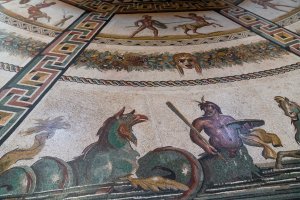
















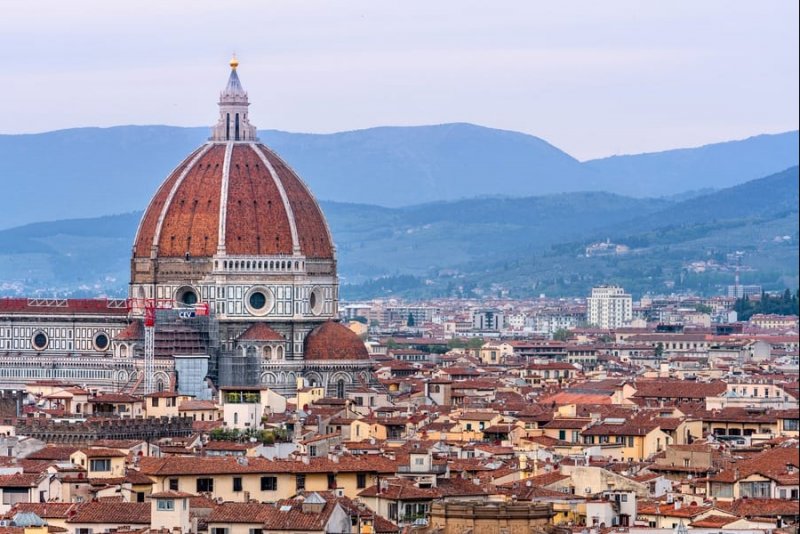









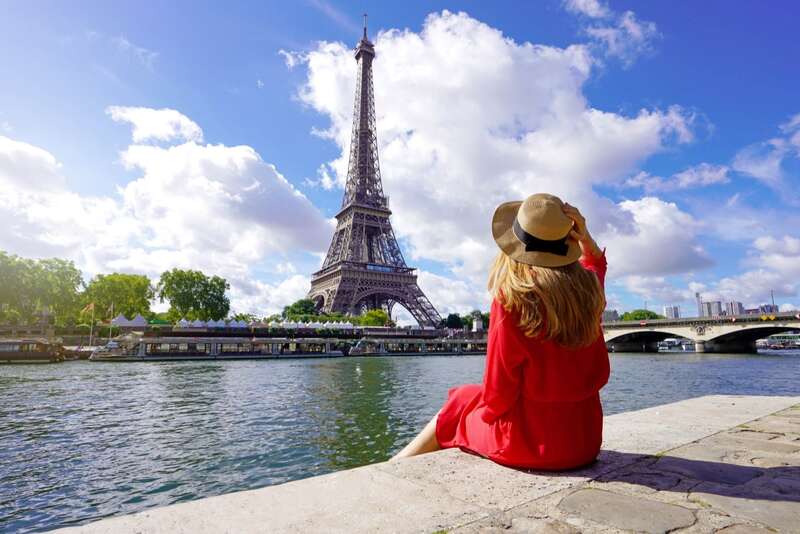

Reader Comments...
"I respond to every comment by direct private email. I look forward to your feedback" - Josh BenderAMAZING POST NICE LOCATION FOR EVERYONE
this is very informative. I learned a lot of information from this post. the article is nicely explained and easy to understand. thanks for sharing this useful information with us. keep it up.
Really good blog
Thanks for sharing such a beautiful informative information on the blog.
my husband and I are going to Paris and Italy(for the 1st time)
As the date is getting near I am panicking. My husband leaves the planning to me.
Your blog definitely helps. Thanks
thank you so much
Write Your Comment
Please DO NOT include links, URLs or HTML in your comments - they will be automated deleted and you will waste your time.